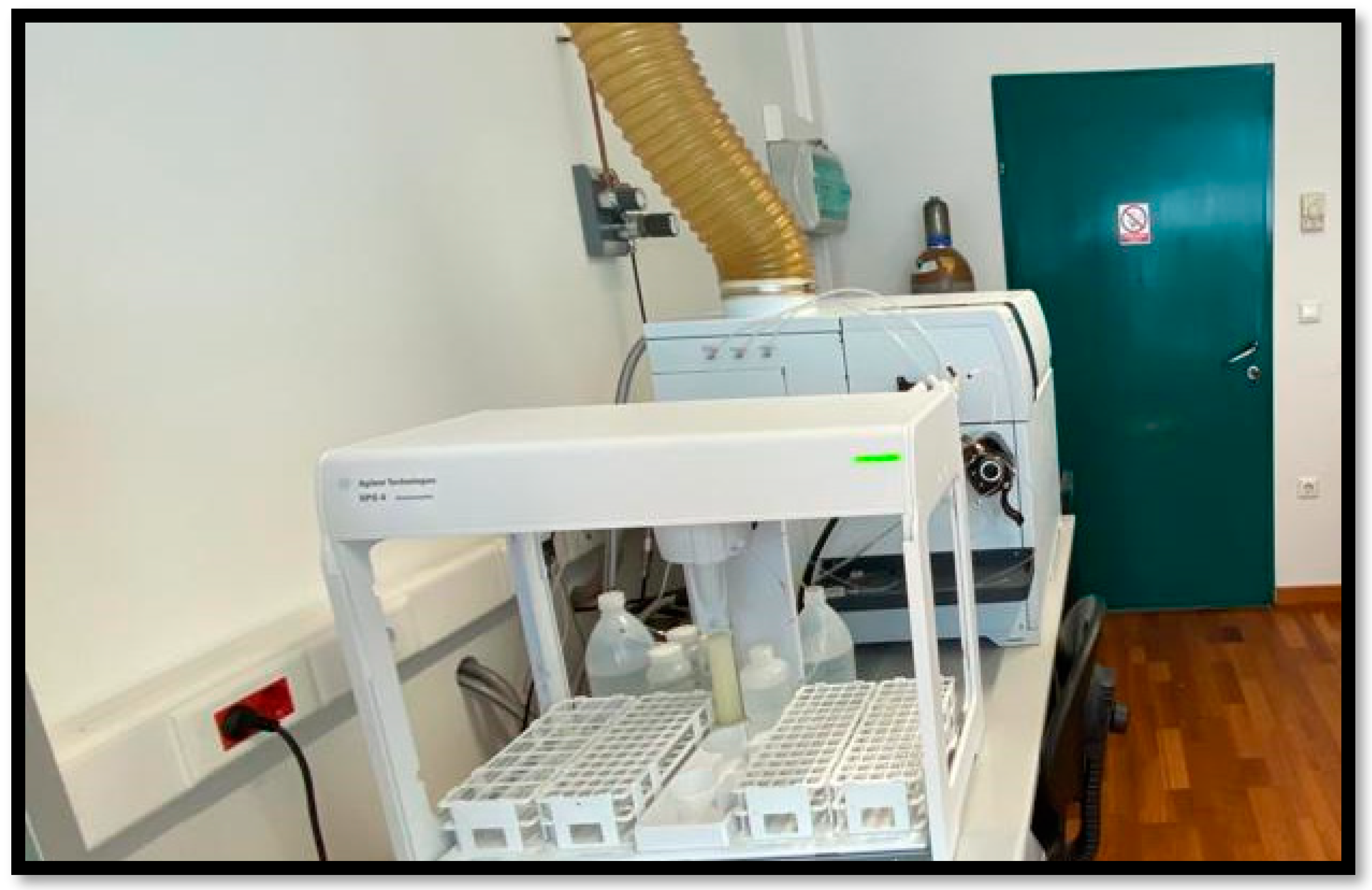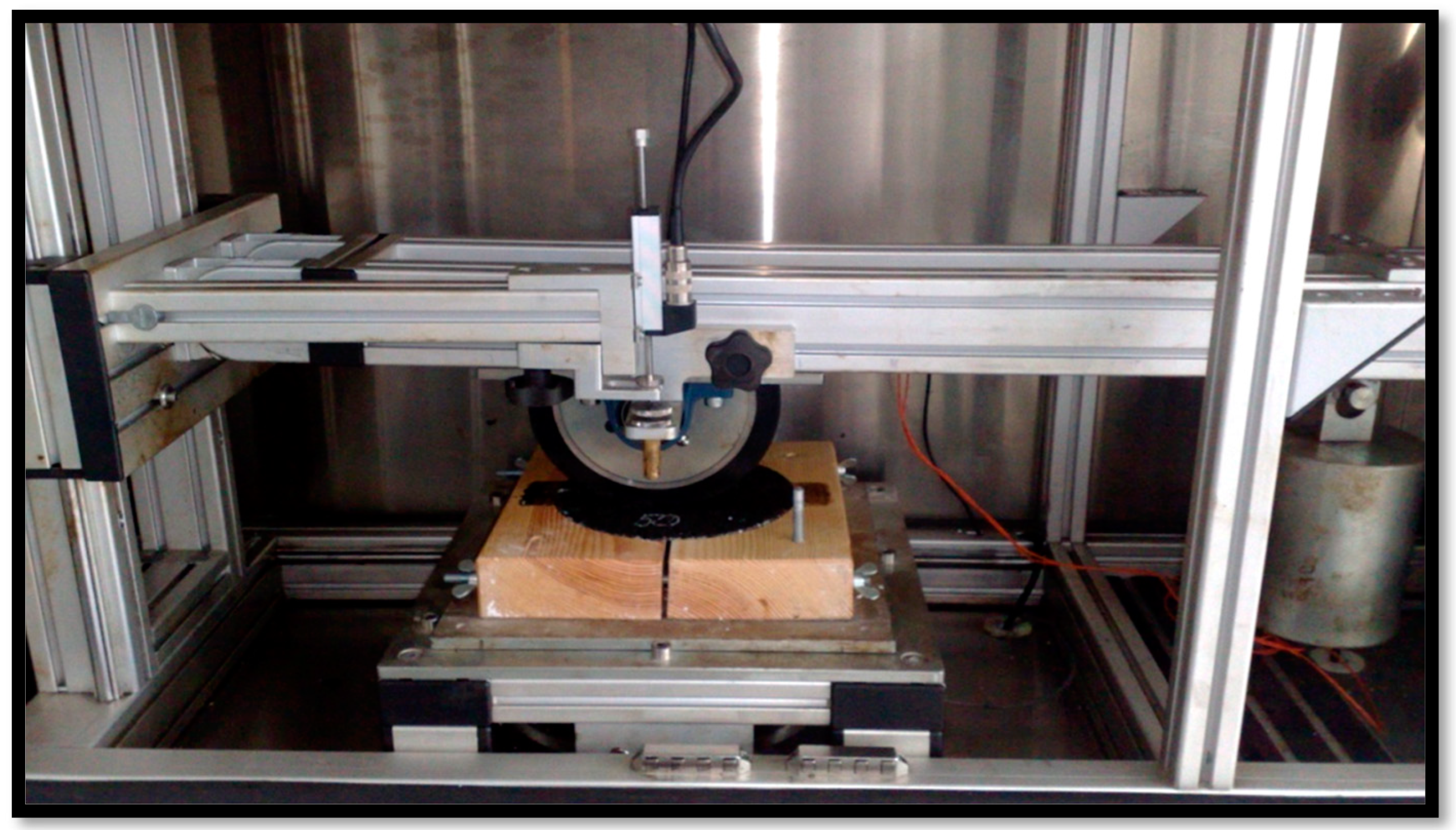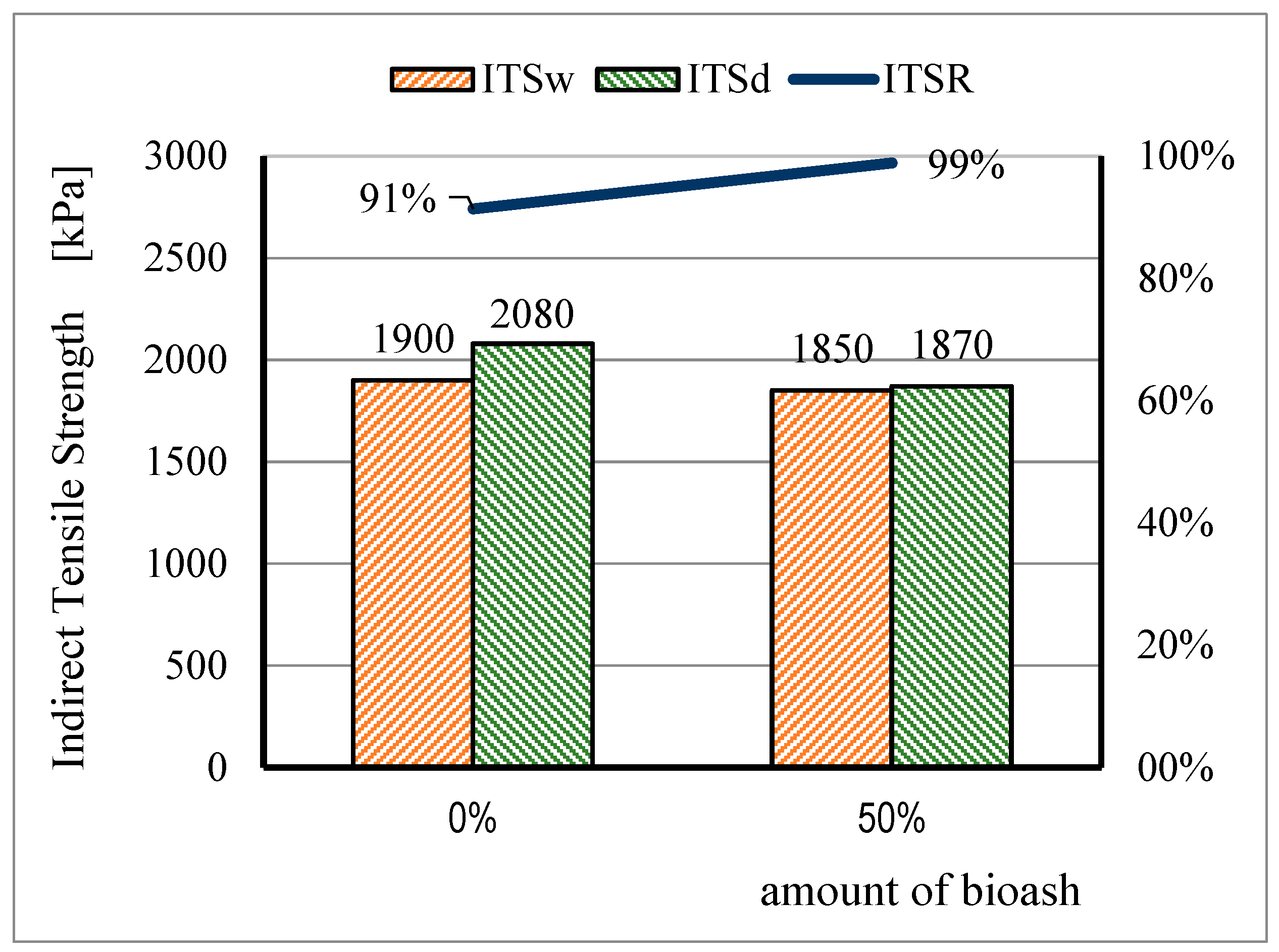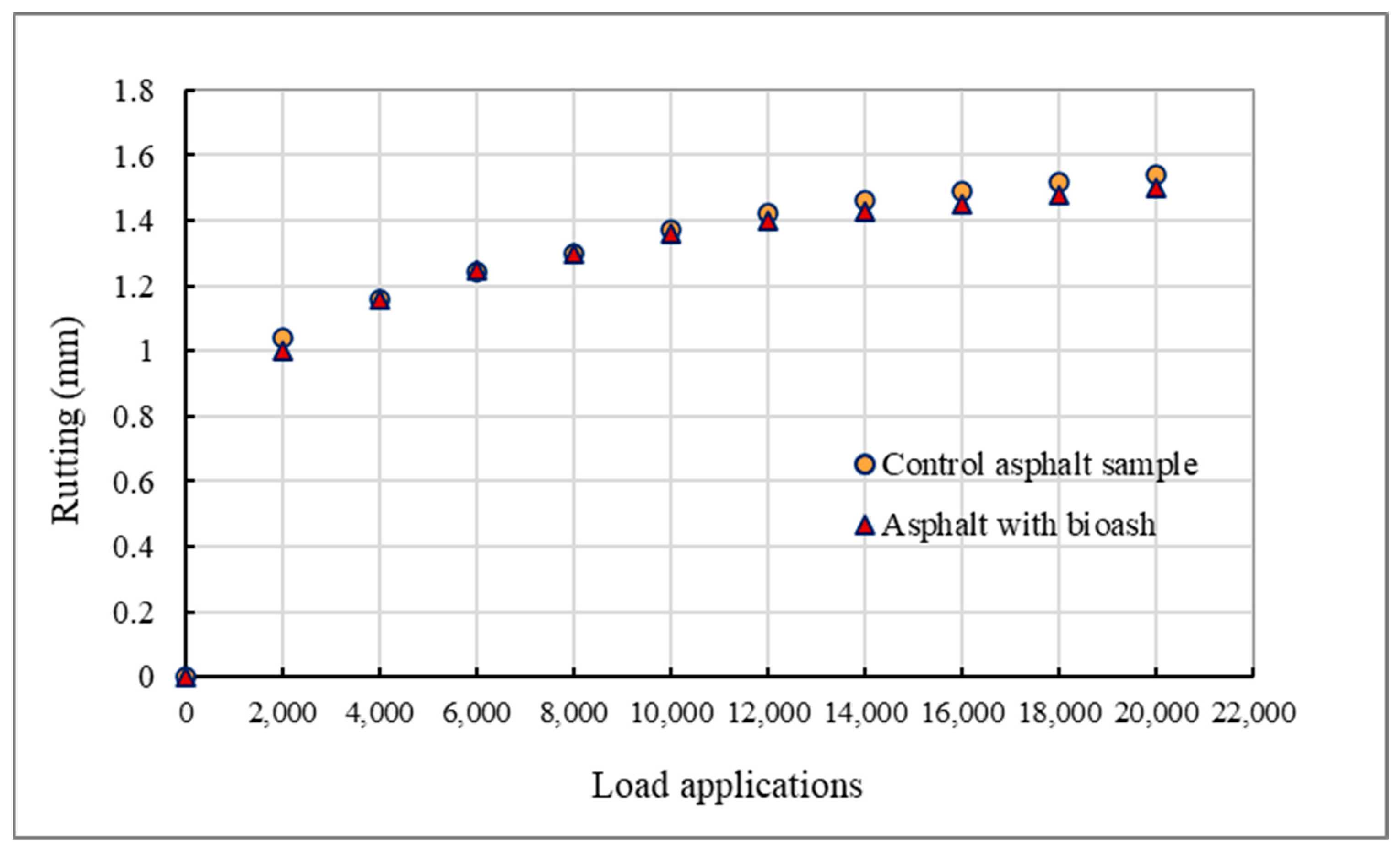Contribution to the Research on the Application of Bio-Ash as a Filler in Asphalt Mixtures
Abstract
:1. Introduction
2. State of the Art
3. Objective of This Study
4. Materials
4.1. Components of the Asphalt Mixture
4.2. Asphalt Mixture Properties and Preparation
5. Test Methods
5.1. Testing the Leaching of Hazardous Substances from a Bituminous Mixture with Bio-Ash
5.2. Testing the Water Sensitivity of Asphalt Samples
- ITSR = indirect tensile strength ratio (%);
- ITSw = indirect tensile strength of wet asphalt sample (kPa);
- ITSd = indirect tensile strength of dry asphalt sample (kPa).
5.3. Testing the Rutting Resistance
- tracking speed WTSair in mm/1000 cycles;
- proportional (%) rut depth PRDair at 10,000 cycles (20,000 passes);
- rut depth RDair in mm after 10,000 cycles (20,000 passes).
- the density of the test sample with 50% bio-ash filler and the density of the control sample with 100% mineral filler;
- the height of the test sample with 50% bio-ash in the filler and the height of the control sample with 100% mineral filler (0% bio-ash).
6. Results and Discussion
6.1. The Results of Hazardous Substance Leaching from Bituminous Mixture with BA
6.2. The Impact of the BA Filler on the Results of Indirect Tensile Strength/Ratio—ITS/ITSR
6.3. The Impact of the BA Filler on the Results of Rutting Resistance
- (1)
- an asphalt sample with 50% BA filler;
- (2)
- an asphalt sample with 100% mineral filler;
- (3)
- the median values of eight samples of the same type of asphalt mixture (AC 11 surf 50/70) using a classic mineral filler without BA.
7. Conclusions
- Due to the hazardous substances (sulfates, content of total dissolved solids (TDS), and total chromium) contained in BA, it cannot be deposited in landfills, and the same applies if it is combined with other similar waste [23]. The tests conducted on a crushed asphalt sample and a compacted asphalt roller with BA as a filler confirm that there are no illegal amounts of discharge; therefore, there is no harmful impact on the environment (Table 6 and Table 7). Bio-ash, covered with bitumen in the asphalt pavement, is protected from the release of harmful substances into the environment;
- A ratio of the indirect tensile strength (ITSR = ITSw/ITSd) of 98.9% confirms the good resistance of asphalt with BA to the action of water, which has a direct impact on the durability of the pavement and, therefore, road maintenance costs;
- By testing the resistance to rutting of the asphalt samples with and without BA, good rutting parameters (WTSair = 0.03 mm/1000 cycles; PRDair = 3.88%; RDair = 1.5 mm) were confirmed. It is important that the addition of bio-ash does not worsen the resistance of the asphalt mixture to the occurrence of plastic deformations, and multiple is used for environmental protection, which also results in positive economic indicators.
- A reduction in the amount of BA waste in landfills and its harmful impact on the environment;
- Enables the use of less industrial stone filler, which is extracted from quarries, the opening and extending of which harm the natural environment;
- Good resistance of the asphalt to the action of water and good resistance to rutting, which directly implies better management of the asphalt pavement.
Author Contributions
Funding
Institutional Review Board Statement
Informed Consent Statement
Data Availability Statement
Acknowledgments
Conflicts of Interest
References
- European Union. Directive 2009/28/EC of the European Parliament and of the Council of 23 April on the promotion of the use of energy from renewable sources. Off. J. Eur. Union 2009, 140, 16–62. [Google Scholar]
- Available online: https://www.hep.hr/projects/renewable-energy-sources/be-to-bioelectric-power-plants/249 (accessed on 16 April 2022). (In Croatian).
- Zagvozda, M.; Dimter, S.; Rukavina, T. The potential of bio ash for utilization in road construction in eastern Croatia. Sel. Sci. Pap.—J. Civ. Eng. 2017, 12, 121–127. [Google Scholar] [CrossRef]
- Demirbas, A. Potential applications of renewable energy sources, biomass combustion problems in boiler power systems and combustion related environmental issues. Prog. Energy Combust. Sci. 2005, 31, 171–192. [Google Scholar] [CrossRef]
- Zagvozda, M.; Dimter, S.; Rukavina, T.; Netinger Grubeša, I. Possibilities of bio ash application in road building. Građevinar 2018, 70, 393–402. [Google Scholar] [CrossRef]
- Vanhanen, H.; Dahl, O.; Joensuu, S. Utilization of wood ash as a road construction material—Sustainable use of wood ashes. In Proceedings of the 2nd International Conference on Final Sinks, Espoo, Finland, 16–18 May 2013. [Google Scholar]
- James, A.K.; Thring, R.W.; Helle, S.; Ghuman, H.S. Ash management review—Applications of the biomass bottom ash. Energies 2012, 5, 3856–3873. [Google Scholar] [CrossRef]
- Bi, Y.C.; Jakarni, F.M. Evaluating properties of wood ash modified asphalt mixtures. IOP Conf. Ser. Mater. Sci. Eng. 2019, 512, 012004. [Google Scholar] [CrossRef]
- Shafabakhsh, G.; Divandari, H.; Reza Sajadi, S. Evaluation of optimum content of rice husk ash to improve the hot asphalt concrete performance. Int. J. Eng. Technol. 2018, 7, 338–346. [Google Scholar] [CrossRef]
- Lu, Z.; Sha, A.; Wang, W.; Junfeng Gao, J. Studying the properties of SBS/Rice husk ash-modified asphalt binder and mixture. Adv. Pavement Mater. Sustain. Transp. Infrastruct. 2020, 2020, 4545063. [Google Scholar] [CrossRef]
- Arabani, M.; Tahami, S.A. Assessment of mechanical properties of rice husk ash modified asphalt mixture. Constr. Build. Mater. 2017, 149, 350–358. [Google Scholar] [CrossRef]
- Raissa, R.; Ramadhansyah, P.J.; Haryati, Y.; Fadzli, M.N.; Agussabti, I.; Dewi, S.J. Effect of black rice husk ash on the physical and rheological properties of bitumen. AIP Conf. Proc. 2017, 1875, 030012. [Google Scholar]
- Zia, A.; Khan, A.A. Effectiveness of bagasse ash for performance improvement of asphalt concrete pavements. SN Appl. Sci. 2021, 3, 502. [Google Scholar] [CrossRef]
- Mansor, S.; Haron, S.; Joohari, M.I.; Razali, M.; Ramli, R. The Effect of Utilizing Fly Ash and Bottom Ash as a Replacement of Mineral Filler in Porous Asphalt Mixtures. IOP Conference Series Materials Science Engineering 2021, 1144, 012086. [Google Scholar] [CrossRef]
- Choudhary, J.; Kumar, B.; Singh, S. Assessment of engineering and environmental suitability of waste bituminous concrete containing waste biomass ash. Int. J. Pavement Res. Technol. 2021, 14, 751–763. [Google Scholar] [CrossRef]
- Zhang, R.; Wang, H.; Ji, J.; Wang, H. Viscoelastic properties, rutting resistance, and fatigue resistance of waste wood-based biochar-modified asphalt. Coatings 2022, 12, 89. [Google Scholar] [CrossRef]
- Arabani, M.; Esmaaeli, N. Laboratory evaluation on effect of groundnut shell ash on performance parameters of asphalt binder and mixes. Road Mater. Pavement Des. 2018, 21, 1565–1587. [Google Scholar] [CrossRef]
- Zainudin, M.Z.M.; Khairuddin, F.H.; Ng, C.P.; Che Osmi, S.K.; Misnon, N.A.; Murniati, S. Effect of sugarcane bagasse ash as filler in hot mix asphalt. Mater. Sci. Forum 2016, 846, 683–689. [Google Scholar]
- Choudhary, J.; Kumar, B.; Gupta, A. Analysis and Comparison of Asphalt Mixes Containing Waste Fillers Using a Novel Ranking Methodology. J. Mater. Civ. Eng. 2020, 32, 04020064. [Google Scholar] [CrossRef]
- Suárez-Macías, J.; Terrones-Saeta, J.M.; Iglesias-Godino, F.J.; Corpas-Iglesias, F.A. Study of the Incorporation of Biomass Bottom Ash as a Filler for Discontinuous Grading Bituminous Mixtures with Bitumen Emulsion. Appl. Sci. 2021, 11, 3334. [Google Scholar] [CrossRef]
- Suárez-Macías, J.; Terrones-Saeta, J.M.; Iglesias-Godino, F.J.; Corpas-Iglesias, F.A. Evaluation of Physical, Chemical, and Environmental Properties of Biomass Bottom Ash for Use as a Filler in Bituminous Mixtures. Sustainability 2021, 13, 4119. [Google Scholar] [CrossRef]
- Melotti, R.; Santagata, E.; Bassani, M.; Salvo, M.; Rizzo, S. A preliminary investigation into the physical and chemical properties of the biomass ashes used as aggregate fillers for bituminous mixtures. Waste Manag. 2013, 33, 1906–1917. [Google Scholar] [CrossRef]
- Dimter, S.; Šimun, M.; Zagvozda, M.; Rukavina, T. Laboratory Evaluation of the Properties of Asphalt Mixture with Wood Ash Filler. Materials 2021, 14, 575. [Google Scholar] [CrossRef] [PubMed]
- HRN EN 13108-1:2008; Bituminous Mixtures—Material Specifications—Part 1: Asphalt Concrete. CEN: Brussels, Belgium, 2006.
- HRN EN 13043:2003; Aggregates for Bituminous Mixtures and Surface Treatments for Roads, Airfields and Other Trafficked Areas. CEN: Brussels, Belgium, 2002.
- HRN EN 12697-2:2019; Bituminous Mixtures—Test Methods—Part 2: Determination of Particle Size Distribution (EN 12697-2:2015+A1:2019). CEN: Brussels, Belgium, 2019.
- HRN EN 933-10:2013; Tests for Geometrical Properties of Aggregates—Part 9: Assessment of Fines—Methylene Blue Test. CEN: Brussels, Belgium, 2013.
- HRN EN 12591:2009; Bitumen and Bituminous Binders—Specifications for Paving Grade Bitumens. CEN: Brussels, Belgium, 2009.
- HRN EN 12697-35:2016; Bituminous Mixtures—Test Methods—Part 35: Laboratory Mixing. CEN: Brussels, Belgium, 2016.
- HRN EN 12697-33:2018; Bituminous Mixtures—Test Methods for Hot Mix Asphalt—Part 33: Specimen Prepared by Roller Compactor. CEN: Brussels, Belgium, 2018.
- HRN EN 12697-30:2019; Bituminous Mixtures—Test Methods for Hot Mix Asphalt—Part 30: Specimen Preparation by Impact Compactor. CEN: Brussels, Belgium, 2018.
- HRN EN 12697-6:2020; Bituminous Mixtures—Test Methods—Part 6: Determination of Bulk Density of Bituminous Specimens. CEN: Brussels, Belgium, 2020.
- HRN EN 12697-5:2019; Bituminous Mixtures—Test Methods—Part 5: Determination of the Maximum Density (EN 12697-5:2018). CEN: Brussels, Belgium, 2019.
- HRN EN 12697-8:2018; Bituminous Mixtures—Test Methods for Hot Mix Asphalt—Part 8: Determination of Void Properties of Bituminous Specimens. CEN: Brussels, Belgium, 2018.
- HRN EN 12697-34: 2012; Bituminous Mixtures—Test Methods for Hot Mix Asphalt—Part 34: Marshall Test. CEN: Brussels, Belgium, 2012.
- HRN EN 12457-4:2005; Characterization of Waste—Leaching—Compliance Test for Leaching of Granular Waste Materials and Sludges—Part 4: One stage batch test at a liquid to solid ratio of 10 l/kg for materials with particle size below 10 mm (without or with size reduction). CEN: Brussels, Belgium, 2002.
- HRN EN ISO 10523:2012; Water Quality—Determination of pH. International Organization for Standardization ISO: Geneva, Switzerland, 2012.
- HRN ISO 9297:1998; Water Quality—Determination of Chloride—Silver Nitrate Titration with Chromate Indicator (Mohr’s Method). International Organization for Standardization ISO: Geneva, Switzerland, 1998.
- HRN ISO 6439:1998; Water Quality—Determination of Phenol Index—4-Aminoantipyrine Spectrometric Method after Distillation. International Organization for Standardization ISO: Geneva, Switzerland, 1990.
- HRN EN 15216:2008; Characterization of Waste—Determination of Total Dissolved Solids (TDS) in Water and Eluates. CEN: Brussels, Belgium, 2007.
- HRN EN 1484:2002; Water Analysis—Guidelines for the Determination of Total Organic Carbon (TOC) and Dissolved Organic Carbon (DOC). CEN: Brussels, Belgium, 1997.
- HRN EN ISO 17294-2:2016; Water Quality—Application of Inductively Coupled Plasma Mass Spectrometry (ICP-MS)—Part 2: Determination of Selected Elements Including Uranium Isotopes. International Organization for Standardization ISO: Geneva, Switzerland, 2016.
- HRN EN 12697-12:2018; Bituminous Mixtures—Test Methods for Hot Mix Asphalt—Part 12: Determination of the Water Sensitivity of Bituminous Specimens. CEN: Brussels, Belgium, 2018.
- HRN EN 12697-22:2020; Bituminous Mixtures—Test Methods—Part 22: Wheel Tracking. CEN: Brussels, Belgium, 2020.
- HRN EN 12697-29:2002; Bituminous Mixtures—Test Methods for Hot Mix Asphalt—Part 29: Determination of the Dimensions of a Bituminous Specimen. CEN: Brussels, Belgium, 2002.
- Ordinance on the Methods and Conditions for Waste Disposal, Categories and Operational Requirements for Landfills, Annex III for Internal Waste, The Official Gazette 114/15, 103/18. Available online: https://narodne-novine.nn.hr/clanci/sluzbeni/2015_10_114_2184.html (accessed on 2 May 2023). (In Croatian).
- Decision 2003/33/EC—Annex: Criteria and Procedures for the Acceptance of Waste at Landfills, Paragraphs 2.1.2.1. and 2.1.2.2. for Internal Waste. Available online: https://ec.europa.eu/environment/pdf/waste/landfill/annexes_a2.pdf (accessed on 2 May 2023).
- Regulation on By-Products and on the Abolition of the Waste Status, The Official Gazette 117/14, Annex V, Item 6. Available online: https://narodne-novine.nn.hr/clanci/sluzbeni/2014_10_117_2217.html (accessed on 2 May 2023). (In Croatian).
- HRN EN 13108-8:2016; Bituminous Mixtures—Material Specifications—Part 8: Reclaimed Asphalt. CEN: Brussels, Belgium, 2016.
- HRN EN 12697-23:2017; Bituminous Mixtures—Test Methods for Hot Mix Asphalt—Part 23: Determination of the Indirect Tensile Strength of Bituminous Specimens. CEN: Brussels, Belgium, 2017.
- Technical Regulations for Asphalt Pavements, Ministry of Spatial Planning, Construction and of State Property, The Official Gazette 48/2021. Available online: https://narodne-novine.nn.hr/clanci/sluzbeni/2021_05_48_977.html (accessed on 2 May 2023). (In Croatian).








| Sieve opening size (mm) | 0.063 | 0.09 | 0.125 | 0.25 | 0.5 | 0.71 | 1 | 2 | 4 | 5.6 | 8 | 11.2 |
| Cumulative passing (%) | 6.6 | 7.0 | 9 | 13 | 19 | 22 | 25 | 35 | 54 | 61 | 78 | 98 |
| Sieve opening size (mm) | 2.0 | 0.125 | 0.063 |
| Cumulative passing (%) | 100 | 78 | 49 |
| Property | Test Method | Specification |
|---|---|---|
| Density at 25 °C (Mg/m3) | MSZ EN ISO 3838 | 1.020 |
| Softening point (°C) | MSZ EN 1427 | 46–54 |
| Penetration at 25 °C (mm 10−1) | MSZ EN 1426 | 50–70 |
| Resistance to hardening at 163 °C | ||
| MSZ EN 12607-1 | Max. +/−0.5 |
| MSZ EN 1426 | Min. 50 |
| MSZ EN 1427 | Min. 9 |
| Flashpoint (°C) | MSZ EN ISO 2592 | Min. 230 |
| Solubility (%) | MSZ EN 12592 | Min. 99 |
| With 50% BA Filler | With 100% Mineral Filler | Test Method | |
|---|---|---|---|
| Bulk density of a compacted asphalt specimen (Mg/m3) | 2.492 | 2.471 | HRN EN 12697-6 [32] |
| Maximum density of an asphalt mixture (Mg/m3) | 2.586 | 2.597 | HRN EN 12697-5 [33] |
| Air Void Content (%) | 3.6 | 4.9 | HRN EN 12697-8 [32] |
| Voids filled with bitumen (%) | 79.6 | 74.4 | HRN EN 12697-8 [34] |
| Marshall Stability (kN) | 11.7 | 10.6 | HRN EN 12697-34 [35] |
| Deformation (mm) | 2.6 | 2.2 | HRN EN 12697-34 [35] |
| Tangential deformations (mm) | 1.3 | 1.2 | HRN EN 12697-34 [35] |
| Total deformations (mm) | 2.9 | 3.5 | HRN EN 12697-34 [35] |
| Marshall Quotient (kN/mm) | 4.5 | 4.8 | HRN EN 12697-34 [35] |
| Characteristic | Test Method |
|---|---|
| Concentration of hydrogen ions (pH) | HRN EN ISO 10523 [37] |
| Fluorides | RU-MET-001 |
| Sulfates | SM23 Ed2017, 4500 E |
| Chlorides | HRN ISO 9297 [38] |
| Phenolic index | HRN ISO 6439 [39] |
| Content of the total dissolved solids (TDS) | HRN EN 15216 [40] |
| Dissolved organic oxide (DOC) | HRN EN 1484 [41] |
| Arsenic (As), Barium (Ba), Cadmium (Cd) | HRN EN ISO 17294-2 [42] |
| Total chromium (Cr), Copper (Cu), Mercury (Hg) | HRN EN ISO 17294-2 |
| Molybdenum (Mo), Nickel (Ni), Lead (Pb) | HRN EN ISO 17294-2 |
| Antimony (Sb), Selenium (Se), Zinc (Zn) | HRN EN ISO 17294-2 |
| Asphalt Sample | Average Height (mm) | Average Diameter (mm) | Average Dry Sample Mass (g) | Average Sample Density (Mg/m3) |
|---|---|---|---|---|
| Dry (four pieces) With 50% BA filler | 64.2 | 101.5 | 1232.2 | 2.412 |
| Dry (four pieces) With 100% mineral filler | 64.5 | 101.4 | 1238.0 | 2.419 |
| Asphalt Sample | Average Height (mm) | Average Diameter (mm) | Average Sample Mass (g) | Average Sample Density (Mg/m3) |
|---|---|---|---|---|
| Wet (four pieces) With 50% BA filler | 63.2 | 101.5 | 1220.5 | 2.415 |
| Wet (four pieces) With 100% mineral filler | 64.0 | 101.4 | 1237.2 | 2.419 |
| Asphalt AC 11 Surf 50/70 | Sample with 50% BA Filler | Sample with 100% Mineral Filler |
|---|---|---|
| Density (Mg/m3) | 2.484 | 2.508 |
| Height (mm) | 38.7 | 42.5 |
| Characteristic, (Unit of Measurement) | Results | Max. Allowed Concentration [46,47,48] |
|---|---|---|
| Fluorides (mg/kg dry matter) | <1.00 | 10 |
| Sulfates (mg/kg dry matter) | <30.0 | 1000 |
| Chlorides (mg/kg dry matter) | <1.00 | 800 |
| Content of total dissolved solids (TDS) (mg/kg dry matter) | 290 | 4000 |
| Dissolved organic oxide (DOC) (mg/kg dry matter) | 32.0 | 500 |
| Arsenic (As) (mg/kg dry matter) | <0.005 | 0.5 |
| Barium (Ba) (mg/kg dry matter) | 0.363 | 20 |
| Cadmium (Cd) (mg/kg dry matter) | <0.005 | 0.4 |
| Total chromium (Cr) (mg/kg dry matter) | 0.006 | 0.5 |
| Copper (Cu) (mg/kg dry matter) | <0.005 | 2 |
| Mercury (Hg) (mg/kg dry matter) | <0.002 | 0.01 |
| Molybdenum (Mo) (mg/kg dry matter) | <0.005 | 0.5 |
| Nickel (Ni) (mg/kg dry matter) | <0.005 | 0.4 |
| Lead (Pb) (mg/kg dry matter) | 0.015 | 0.5 |
| Antimony (Sb) (mg/kg dry matter) | <0.005 | 0.06 |
| Selenium (Se) (mg/kg dry matter) | <0.005 | 0.1 |
| Zinc (Zn) (mg/kg dry matter) | <0.005 | 4 |
| Characteristic, (Unit of Measurement) | Results | Max. Allowed Concentration [46,47,48] |
|---|---|---|
| Fluorides (mg/kg dry matter) | 0.433 | 10 |
| Sulfates (mg/kg dry matter) | 13.3 | 1000 |
| Chlorides (mg/kg dry matter) | <12.0 | 800 |
| Content of total dissolved solids (TDS) (mg/kg dry matter) | <12.0 | 4000 |
| Dissolved organic oxide (DOC) (mg/kg dry matter) | 30.7 | 500 |
| Arsenic (As) (mg/kg dry matter) | <0.005 | 0.5 |
| Barium (Ba) (mg/kg dry matter) | 0.077 | 20 |
| Cadmium (Cd) (mg/kg dry matter) | <0.005 | 0.4 |
| Total chromium (Cr) (mg/kg dry matter) | <0.005 | 0.5 |
| Copper (Cu) (mg/kg dry matter) | <0.005 | 2 |
| Mercury (Hg) (mg/kg dry matter) | <0.002 | 0.01 |
| Molybdenum (Mo) (mg/kg dry matter) | <0.005 | 0.5 |
| Nickel (Ni) (mg/kg dry matter) | <0.005 | 0.4 |
| Lead (Pb) (mg/kg dry matter) | 0.016 | 0.5 |
| Antimony (Sb) (mg/kg dry matter) | <0.005 | 0.06 |
| Selenium (Se) (mg/kg dry matter) | <0.005 | 0.1 |
| Zinc (Zn) (mg/kg dry matter) | <0.005 | 4 |
| Number of Passes | The Depth of the Rut for Asphalt 50% BA (mm) | The Depth of the Rut for Asphalt 100% Mineral Filler (mm) |
|---|---|---|
| 0 | 0.00 | 0.00 |
| 2000 | 1.00 | 1.04 |
| 4000 | 1.16 | 1.16 |
| 6000 | 1.25 | 1.24 |
| 8000 | 1.30 | 1.30 |
| 10,000 | 1.36 | 1.37 |
| 12,000 | 1.40 | 1.42 |
| 14,000 | 1.43 | 1.46 |
| 16,000 | 1.45 | 1.49 |
| 18,000 | 1.48 | 1.52 |
| 20,000 | 1.50 | 1.54 |
| The Rutting Parameter | Asphalt Sample 50% BA | Asphalt Sample 100% Mineral Filler | Asphalt Compared 8 Samples without BA | Max. Allowed Value [51] |
|---|---|---|---|---|
| (1) | (2) | (3) | ||
| Tracking speed WTSair (mm/1000 cycles) | 0.03 | 0.04 | 0.03 | 0.07 |
| Relative (%) rut depth PRDair at 10,000 cycles | 3.88 | 3.66 | 3.68 | 7.00 |
| Rut depth RDair (mm) after 10,000 cycles | 1.50 | 1.54 | 1.36 | - |
Disclaimer/Publisher’s Note: The statements, opinions and data contained in all publications are solely those of the individual author(s) and contributor(s) and not of MDPI and/or the editor(s). MDPI and/or the editor(s) disclaim responsibility for any injury to people or property resulting from any ideas, methods, instructions or products referred to in the content. |
© 2023 by the authors. Licensee MDPI, Basel, Switzerland. This article is an open access article distributed under the terms and conditions of the Creative Commons Attribution (CC BY) license (https://creativecommons.org/licenses/by/4.0/).
Share and Cite
Šimun, M.; Dimter, S.; Grubješić, G.; Vukelić, K. Contribution to the Research on the Application of Bio-Ash as a Filler in Asphalt Mixtures. Appl. Sci. 2023, 13, 6555. https://doi.org/10.3390/app13116555
Šimun M, Dimter S, Grubješić G, Vukelić K. Contribution to the Research on the Application of Bio-Ash as a Filler in Asphalt Mixtures. Applied Sciences. 2023; 13(11):6555. https://doi.org/10.3390/app13116555
Chicago/Turabian StyleŠimun, Miroslav, Sanja Dimter, Goran Grubješić, and Karolina Vukelić. 2023. "Contribution to the Research on the Application of Bio-Ash as a Filler in Asphalt Mixtures" Applied Sciences 13, no. 11: 6555. https://doi.org/10.3390/app13116555





